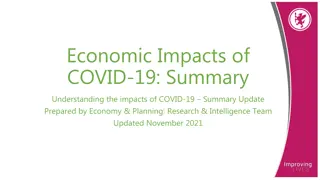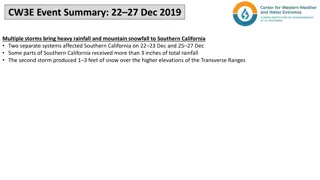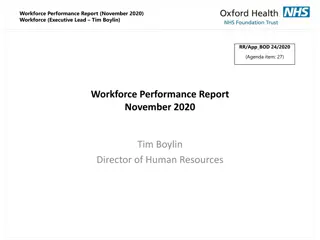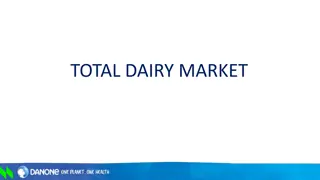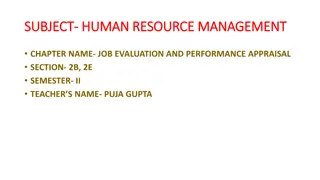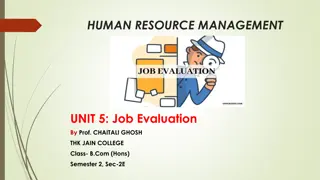Buckinghamshire Job Vacancies December 2021 Summary & Trends
Providing insights into the job market in Buckinghamshire, the report highlights a continuous rise in job postings compared to pre-pandemic levels. Key sectors with high demand include administrative, customer service, healthcare, and IT roles. Notable employers contributing to job openings include the NHS, Buckinghamshire Council, and major corporations like Danaher and Softcat. The data reflects positive trends in job postings, illustrating a strong rebound post-Covid and signaling a thriving employment landscape in Buckinghamshire.
Download Presentation

Please find below an Image/Link to download the presentation.
The content on the website is provided AS IS for your information and personal use only. It may not be sold, licensed, or shared on other websites without obtaining consent from the author. Download presentation by click this link. If you encounter any issues during the download, it is possible that the publisher has removed the file from their server.
E N D
Presentation Transcript
Job Vacancies within Buckinghamshire December 2021
Background This slide deck provides a monthly summary of recruitment trends within Buckinghamshire. Data is sourced from Burning Glass Technologies via the Labour Insight platform. Data is generated by scraping information from job adverts posted on-line Further details can be found here. To monitor the impact of Covid-19 on the labour market, and track the speed of economic recovery, data within this report is either benchmarked against Quarter 1 (January to March) 2020, or is benchmarked against the corresponding month in 2019. Further details, including some caveats to be aware are, can be found at the end of this slide deck.
Headlines November 2021 The number of job postings in Buckinghamshire remain higher than pre- pandemic benchmarks and rebounded strongly in November 2021 following recent falls. Between October and November 2021, there was a 25% rise in job postings, which followed a 6% fall between September and October 2021. In comparison, job postings increased 27% nationally between October and November 2021. Roles with the most job postings for November 2021 in Buckinghamshire included administrative occupations, customer service occupations, nurses and care occupations, labourers, account, project and sales managers and software developers. Demand for teamwork, collaboration, sales, project management, KPIs and customer contact skills was greater in Q3 2021 than Q3 2020. This compares to reduced demand for skills in customer service, teaching, accounting and staff management. Visible employers with the most job openings between September and November 2021 include the NHS, Buckinghamshire Council, the Buckinghamshire Healthcare Trust, the Danaher Corporation and Softcat Plc.
Monthly Job Postings: 2020-21 8,000 900,000 Buckinghamshire England 800,000 7,000 700,000 6,000 600,000 5,000 500,000 4,000 400,000 3,000 300,000 2,000 200,000 1,000 100,000 - -
Number of online job postings in Buckinghamshire by month 2019 2020 2021 8,000 Number of job postings 7,000 6,000 5,000 4,000 3,000 2,000 1,000 -
Variation within Buckinghamshire Job postings in Buckinghamshire during September 2021 to November 2021 are higher overall compared to the same period pre-Covid. Number of job postings Sep 19-Nov 19 (pre-Covid benchmark) Sep 21-Nov 21 (latest 3 months) Change Change (%) Within Buckinghamshire, Chiltern has had the largest rise in the number of job postings. Wycombe 4,810 5,650 +840 +17% Aylesbury Vale 2,940 4,170 +1,230 +42% Job postings in Buckinghamshire increased less significantly compared to the South East region and England as a whole. South Bucks 960 1,490 +530 +55% Chiltern 960 1,520 +560 +58% 13,380 18,840 Buckinghamshire +5,460 +41% Note some job postings state the job location as being Buckinghamshire only. These cannot therefore be coded to sub- areas. Hence why the data for Buckinghamshire is higher than the data for the four former districts combined. South East England 286,700 448,150 +161,450 +56% England 1,435,130 2,157,140 +722,010 +50%
Top occupational groups by number of job postings November 2021 0 50 100 150 200 250 300 Office / Administrative Assistant Customer Service Representative Registered General Nurse (RGN) Caregiver / Personal Care Aide Labourer / Material Handler Account Manager / Representative Teaching Assistant Project Manager Software Developer / Engineer Delivery Driver Care assistant General cleaner Sales Manager Receptionist Primary School Teacher Chef Computer Support Specialist Bookkeeper / Accounting Clerk Sales Assistant Retail Sales Associate Marketing Manager Sales Representative Warehouse / Inventory Associate Recruiter Data for Buckinghamshire Accountant
Increased demand: occupations with more job postings in Bucks in Q3 2021 than Q3 2020 0 100 200 300 400 500 600 Office / Administrative Assistant Customer Service Representative Account Manager / Representative Project Manager Chef Sales Assistant Marketing Manager Bookkeeper / Accounting Clerk Labourer / Material Handler Receptionist Accountant Recruiter Sales Representative Human Resources / Labour Relations Specialist Admin, sales and customer service roles Chefs and kitchen staff Construction roles Finance roles Digital and data analysis roles Recruiters Kitchen Staff Sales Manager Software Developer / Engineer Production Worker Computer Support Specialist Data / Data Mining Analyst Senior Administrator Retail Sales Associate General cleaner Teaching Assistant Civil Engineer Source: Labour Insight Credit Analyst / Authoriser
Reduced demand: occupations with fewer job postings in Bucks in Q3 2021 than Q3 2020 -40 -35 -30 -25 -20 -15 -10 -5 0 Primary School Teacher Electronics Engineer Veterinarian Maths Teacher Payroll Specialist Product Development Engineer English / Language Arts Teacher HGV / LGV Class 1 Driver Science Teacher Procurement Manager Supply Teacher Auditor Chief Information Officer / Director of Information Technology Maintenance Technician Forklift / Pallet Jack Operator Dental Assistant Caregiver / Personal Care Aide Interpreter / Translator Registered Mental Nurse (RMN) Stocking Clerk / Sales Floor Support Teaching roles Engineering roles Veterinarian Payroll specialist Nursing and social care HGV / LGV Class 1 Driver Source: Labour Insight
Changing demand for skills baseline skills The chart shows the change in demand for the top baseline skills (as cited within job postings) between Quarter 3 (Jul-Sep) 2020 and Quarter 3 (Jul-Sep) 2021. Q3 2021 Q3 2020 1. Communication Skills 1. Communication Skills 2. Organisational Skills 2. Organisational Skills There has been a relative increase in demand for skills in: detail-orientated (4th to 3rd) Microsoft Excel (5th to 4th) problem solving (7th to 6th) Microsoft Office (11th to 7th) building effective relationships (12th to 8th) 3. Planning 3. Detail-Orientated 4. Detail-Orientated 4. Microsoft Excel 5. Microsoft Excel 5. Planning 6. Creativity 6. Problem Solving 7. Problem Solving 7. Microsoft Office 8. Building Effective Relationships 8. Writing And a relative decrease in demand for skills in: planning (3rd to 5th), writing (8th to 9th) English (9th to 10th). creativity (6th to 11th) leadership (10th to 12th) 9. English 9. Writing 10. Leadership 10. English 11. Microsoft Office 11. Creativity 12. Building Effective Relationships 12. Leadership
Changing demand for skills specialist skills The chart shows the change in demand for the top specialised skills demand (as cited within job postings) between Quarter 3 (Jul- Sep) 2020 and Quarter 3 (Jul-Sep) 2021. Q3 2021 Q3 2020 1. Teamwork / Collaboration 1. Customer Service 2. Teamwork / Collaboration 2. Customer Service 3. Teaching 3. Sales 4. Budgeting 4. Budgeting Demand increased for skills in teamwork / collaboration (2nd to 1st), sales (5th to 3rd), project management (6th to 5th), KPIs (10th to 7th) and customer contact (12th to 10th). 5. Sales 5. Project Management 6. Project Management 6. Teaching 7. Accounting 7. KPIs 8. Cleaning 8. Cleaning 9. Staff Management 9. Accounting 10. KPIs 10. Customer Contact There were declines in demand for: customer service (1st to 2nd) teaching (3rd to 6th) accounting (7th to 9th) staff management (9th to 15th) 12. Customer Contact 15. Staff Management
Demand for computer and programming skills This table shows the top computer and programming skills featured in job postings for Buckinghamshire for the month of November 2021. Most sought computer and programming skills by Bucks employers National Growth Category Global Growth Category Microsoft Excel Microsoft Office Microsoft PowerPoint Microsoft Word SAP SQL Customer Relationship Management (CRM) Enterprise Resource Planning (ERP) Software Development Stable Stable Stable Stable Stable Stable Stable Stable Stable Stable Stable Stable Stable Growing Four Microsoft Office suite programmes feature in the top five. Demand for Customer Relationship Management skills is growing globally. Stable Stable Growth categories are stable for all other computer and programming skills. Stable Stable JavaScript Stable Stable
Some employers with the most job openings in Buckinghamshire September to November 2021 Many employers chose not to provide their name when recruiting via a recruitment agency or job site. National Health Service Buckinghamshire Council Buckinghamshire Healthcare Trust Danaher Corporation This table is therefore based on the 50% of job postings which can be linked to an employer ( visible employers) Softcat Plc Johnson & Johnson Buckinghamshire New University Visible employers with the most job openings September to November 2021 are primarily in the Human Health and Social Work sector. BP The Fremantle Trust Intercontinental Hotels Group Boston Consulting Group Dunbar Education F.I.S Limited Barchester Healthcare SAS Software Limited Source: Burning Glass Technologies Note: 50% of records have been excluded because they do not include an employer. As a result, the chart above may not be representative of the full sample.
About the data Online job postings provide a useful, real-time indication of the characteristics and health of local labour markets. However, limitations of online job posting data include: Some jobs not commonly advertised online (e.g. those often filled through word-of-mouth or adverts in windows) The employer s name often not being included in the job posting, which makes it difficult to glean a complete picture of the top recruiting employers in an area, and makes it difficult to assign jobs to industries. The location not being provided in the job posting, in part due to the increased prevalence of remote working. Burning Glass Technologies classifications of skills are: Specialised skills - covers skills that are specific to an occupation, such as lesson planning for teachers, or Primary Care for nurses. Baseline skills - are sometimes also called soft skills or transferable skills . They include skills that are useful across a variety of occupations, such as research or staff coordination . Computer and programming skills - are IT skills ranging from widely applicable (e.g. Microsoft Word ) to highly specialised (e.g. PERL ).
















